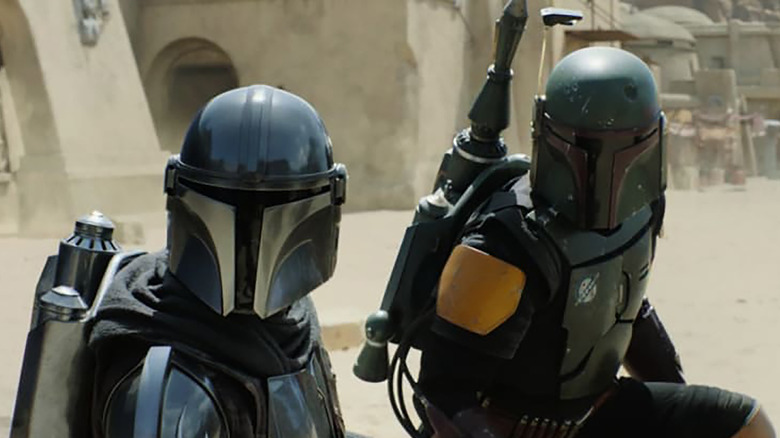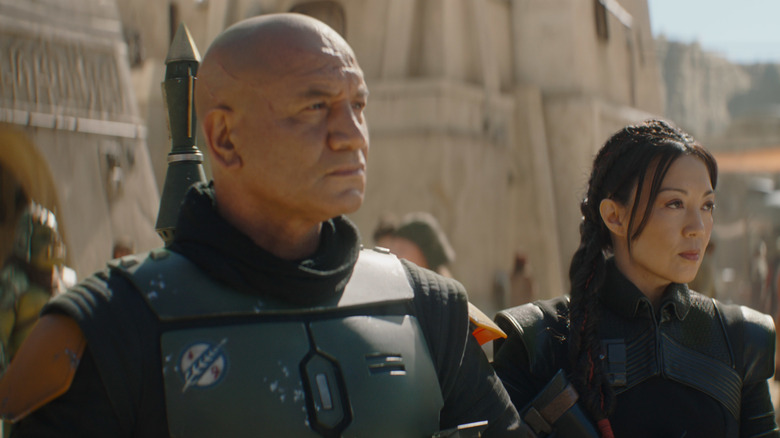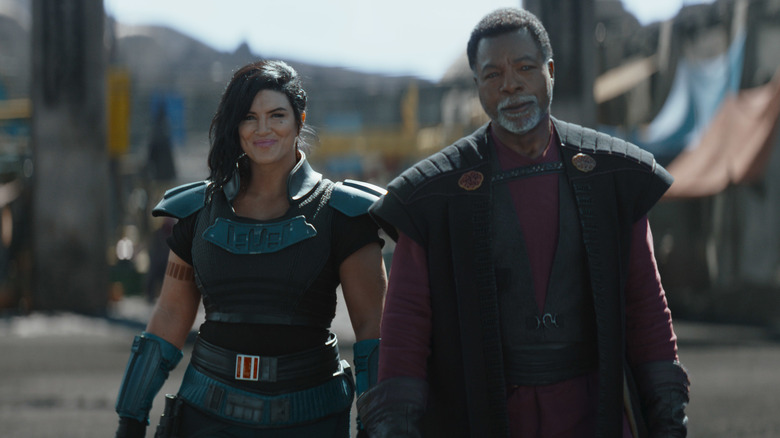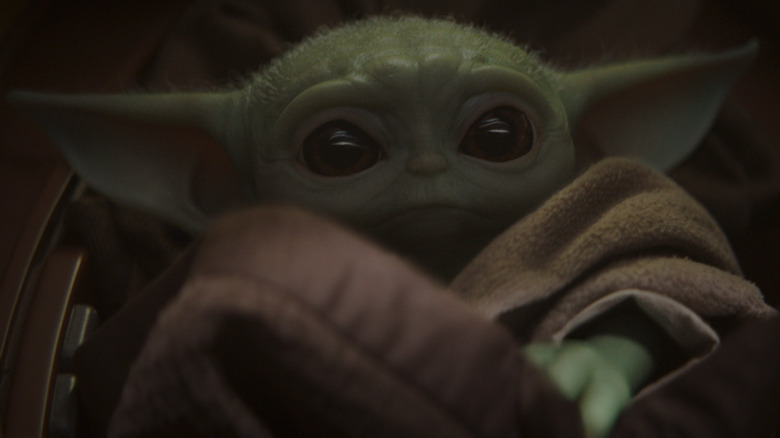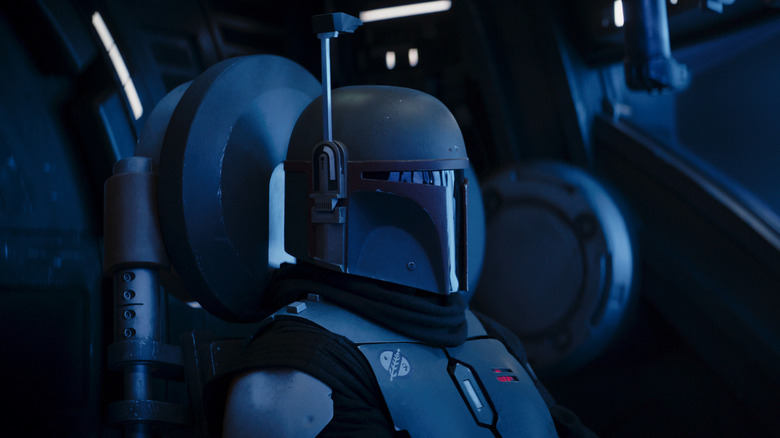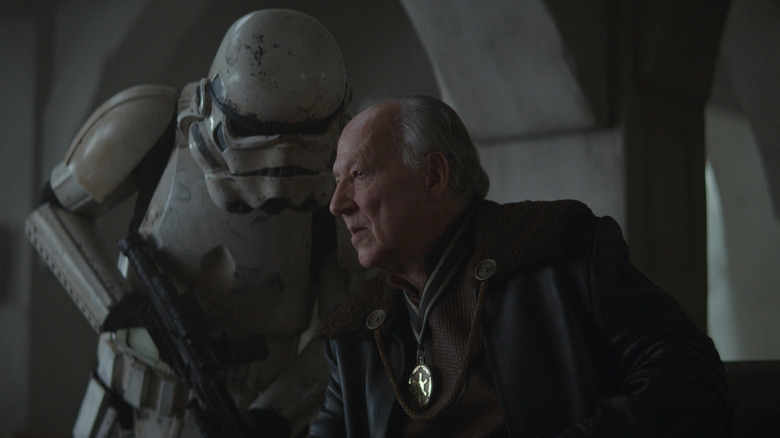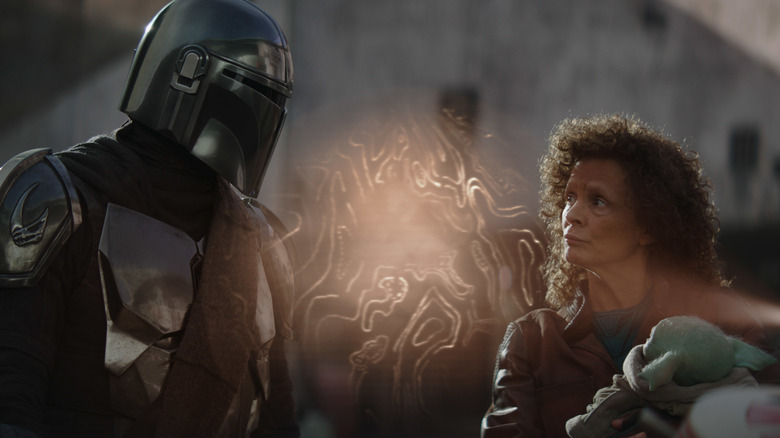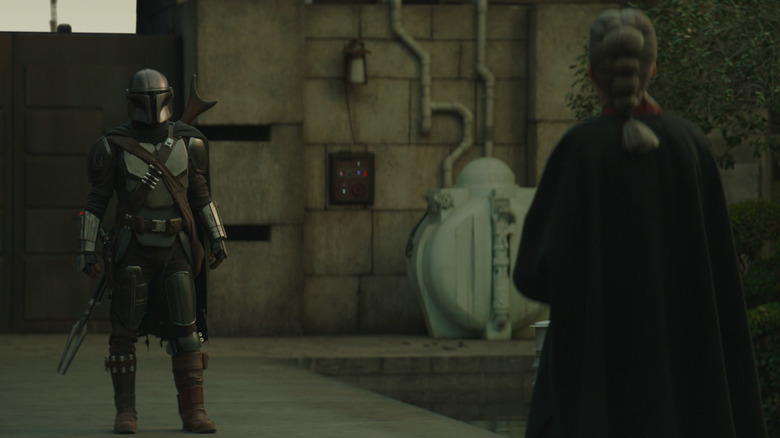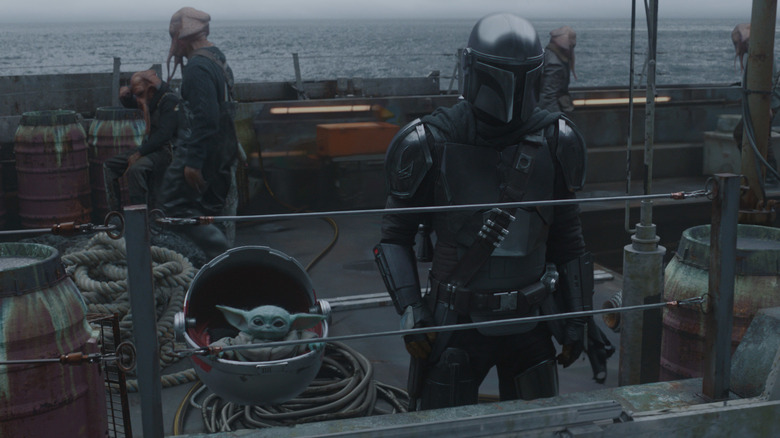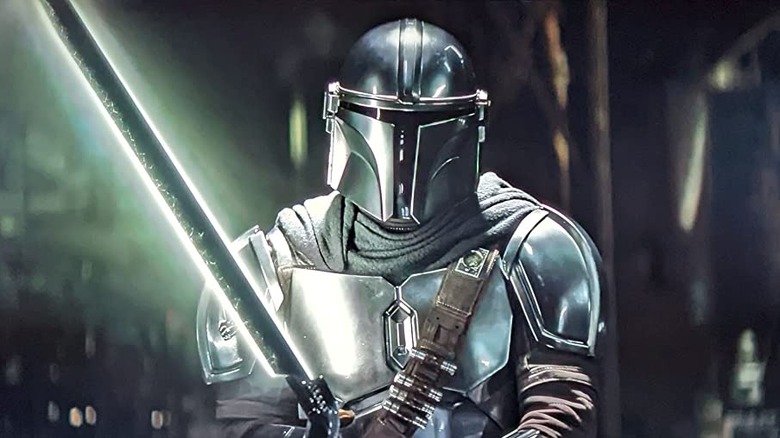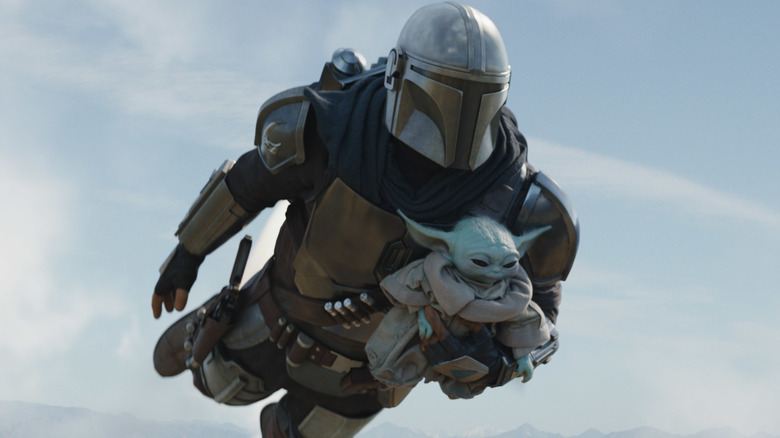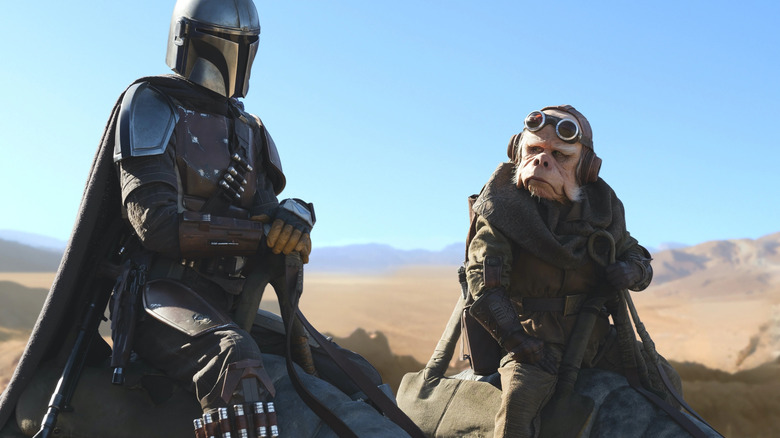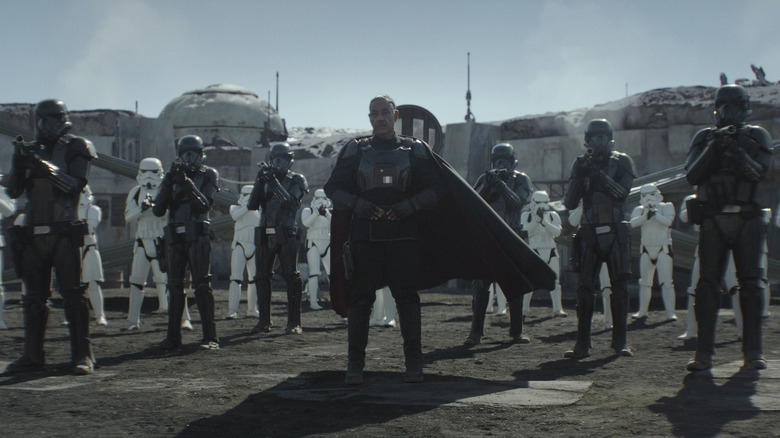The Best Episodes Of Disney's Mandoverse So Far, Ranked
"The Mandalorian" coasted to Season 3 partially because the series has been a critical and commercial success from the start, and partially because this is The Way. The new season marks the fourth entry in Disney's Mandoverse — the collected televised setting that also includes "The Mandalorian" Season 1 and 2 and "The Book of Boba Fett." The Mandoverse's titular bounty hunter Din Djarin (Pedro Pascal) and his adorable infant ward Grogu have helped cement the majority of "The Mandalorian" episodes as modern classics, as well as a couple episodes of Fett's (Temuera Morrison) supposedly solo series. Yet even among all the golden entries into the franchise, some shine brighter than the rest, with a choice few glinting like newly forged Beskar in the Tatooine suns.
Like any series, Djarin and Fett's have their weaker entries and their stronger entries, and exactly which episodes belong to either category is a matter of debate among fans. Thankfully, consensus score platforms like Rotten Tomatoes can provide us a benchmark from which to rank episodes with some degree of objectivity, which is especially necessary for those of us who become smitten with sequences like Fett riding a Rancor and forget all sense of analysis. As the Mandoverse once again flies forward at the speed of a refurbished Naboo starfighter, let's pause to look backward at the best episodes of Disney's Mandoverse so far, ranked.
12. From the Desert Comes a Stranger
It's no secret that "The Book of Boba Fett" didn't receive the same near-universal acclaim as "The Mandalorian," but that doesn't mean it didn't score big with a couple of its episodes. One such score was "From the Desert Comes a Stranger," the penultimate episode of the show's first — and hopefully not last — season. Pulling in an admirable 90% approval rating on Rotten Tomatoes, the episode earned its spot among the great entries in the Mandoverse. Unfortunately for Fett, however, the episode and all its praise belong to its real stars — the Mandalorian and Grogu.
Ostensibly, "The Book of Boba Fett" is just that — a story chronicling the adventures of Fett. In reality, the majority of the first season's final three episodes are dedicated to Djarin, though they ultimately benefit from it. "From the Desert Comes a Stranger" follows Djarin as he pulls double duty, recruiting the people of Freetown to Fett's side and paying a visit to Grogu, whom he misses as a father would a son. The majority of the episode's charm comes from its many guest appearances. In addition to Djarin himself, we're treated with Cobb Vanth (Timothy Olyphant), Grogu, Ahsoka Tano (Rosario Dawson), and most thrillingly of all, the entire franchise's de facto protagonist, Luke Skywalker (Mark Hamill).
11. The Siege
Just a few minutes into "The Mandalorian" Season 2, Episode 4, "The Siege," Djarin tells Grogu, "We need to visit some friends for repairs," unintentionally echoing exactly what makes the episode and so many like it beloved. If the series ever lags, it always has the nostalgia of familiar faces to propel it forward — a trick the show employs even when it's already riding high. A prime example is "The Siege," which is tasked with following up on the success of the episode before it (the buzzworthy "The Heiress") and succeeds largely due to the inclusion of some well-loved familiar faces.
In the case of "The Siege," the friends in question are Greef Karga (Carl Weathers) and Cara Dune (Gina Carano), two of Djarin's fellow mercenaries and closest allies from his Season 1 battles against the remnants of the Empire. Ironically, Weathers thinks Djarin is better off as a "lone wolf," and yet shows up in the role of Karga often to play the Mandalorian's loyal fellow conspirator. Before Carano destroyed her own career with a series of offensive and deeply stupid social media posts, Dune became a reliably tough ally to Djarin in the series' first two seasons. The three mercenaries reunite several times to take on the Empire, and one such fight makes up almost the entirety of the 92% fresh action romp that is "The Siege."
10. The Child
Several of the biggest critical hits for "The Mandalorian" came early in Season 1, as Din Djarin first starts evolving from a stoic soldier of fortune to a selfless crusader and caring parent. The first big step on that journey is Episode 2, aptly named "The Child," which sits at an impressive 93% on Rotten Tomatoes — an unsurprising score, given how much there is to love in the episode. On top of Djarin's first turns toward tenderness, the episode also features the charismatic moisture farmer Kuiil (Nick Nolte), longtime Star Wars staples the Jawas, and the first tease of Grogu's extraordinary innate Force powers.
One of the shortest entries in the entire Mandoverse, "The Child" nonetheless accomplishes a lot. After beginning with a scene in which Djarin discovers his beloved Razor Crest stripped apart by Jawas, we zip along through a fight against those Jawas, a fight against a wild Tatooine Mudhorn, and the most adorable use of the Force yet as it emanates from Grogu's tiny, mint-green claws. After that, Djarin and the titular child blast off into space en route to Nevarro, and we're left with the sated feeling of having seen an entire "Star Wars" epic, despite only tuning in for a half hour.
9. The Rescue
For almost two-and-a-half years, the Season 2 finale was the last episode of "The Mandalorian" we had (unless you count "The Book of Boba Fett," which many have dubbed Season 2.5). As far as last episodes go, however, with a 94% fresh, "The Rescue" contains enough earned emotionality and dazzling action to keep the Mandoverse buzz buzzing for as long as it has to.
The episode stands tall enough on its own thanks to its central premise of an all-hands-on-deck rescue of Grogu from Moff Gideon (Giancarlo Esposito), and how well it pulls the high-stakes operation off. For most, the dueling emotional beats of a cowering, frightened Grogu and a worried, borderline pleading Djarin are enough to get invested in their conflict. For those somehow immune to the plight of the child and his surrogate father, "The Rescue" comes with a contingency plan — more cameos and deep-cuts from the expanded universe than you can shake a Darksaber at.
There's the Darksaber itself, the Mandalorian Bo-Katan (a fan-favorite from "The Clone Wars," and played here by the same actress that originally voiced her, Katee Sackhoff), her sidekick Koska Reeves (pro wrestling star Mercedes Varnado), and the Dark Troopers — the infamous foes introduced way back in the 1995 computer game "Star Wars: Dark Forces." More important than any of those, however, is the shocking appearance of Luke Skywalker in the first time we've seen him look this young since 1983's "Return of the Jedi."
8. The Sin
Plenty of "The Mandalorian" centers on Din Djarin's personal growth and attachment to another, both of which are atypical traits for a bounty hunter and almost unheard of for a Mandalorian. As a nod to Djarin's mold-breaking, which could alternately be described as rule-breaking, this episode is titled "The Sin." Based on its 94% fresh rating on Rotten Tomatoes, most critics found Djarin's emotional rebellion less sinful and more sinfully sweet.
After "The Child" gives us our first slight teases of Djarin's fondness for Grogu, "The Sin" pries the mercenary's armor open and reveals his creamy center in a profoundly surprising way. As the Midwest Film Journal put it in their review, "There is so much plot and character development here that it honestly feels like the final part of a three-hour pilot... In a lesser show, all of these moments would've come later or been protracted." As they noted, "The Sin" sends Djarin on a jump through hyperspace, turning the erstwhile apathetic manhunter into a bona fide sweetheart. He breaks the bounty hunter code by asking his client (Werner Herzog, incredibly) what will become of his target, aka Grogu. When Djarin isn't satisfied with the client's answer, he decides to break every rule in the book in order to keep that precious little baby safe.
7. The Marshal
Beginning the top half of our list is "The Marshal," the Season 2 premiere of "The Mandalorian," which earned itself a whopping 95% critic score on Rotten Tomatoes. More importantly, it proved the Season 1 magic was still in effect.
With "The Marshal," the series begins expanding its central mythology, specifically by setting Djarin on a quest to find other Mandalorians, wherever they may be in the galaxy. It turns out that a potential Mandalorian has been spotted in Djarin's backyard, Tatooine — a huge surprise to Djarin, but not to fans who are used to the franchise finding any excuse to return to the desert home of Anakin and Luke.
The identity of the alleged Mandalorian on Tatooine is a two-for-one. At first, it appears to be the small-town sheriff Vanth, a treat for any fans of Timothy Olyphant (and especially those who love him for his roles in Westerns). Soon, however, we find out that the armor is not Vanth's at all, but rather Boba Fett's, and we even get our first glimpse at Fett in live action since 2002's "Attack of the Clones." Add to that the first appearance and fight of a living, live-action Krayt dragon, and you have a piece of "Star Wars" media sure to make any longtime fan salivate.
6. The Jedi
Rosario Dawson plays a live-action, grown-up Ahsoka Tano. Grand Admiral Thrawn is mentioned for the first time in live action. We finally learn the name of Djarin's sweet little Force-sensitive ward. There's a lot that "The Jedi" has to offer fans of the larger "Star Wars" universe, but more importantly than anything else, the episode is a simple but masterful standalone samurai-Western hybrid tale. Critics and fans almost unanimously agreed, certifying the installment 96% fresh on Rotten Tomatoes and praising everything from its writing and heart to its special effects and score (which, like the rest of the series' music, was composed by the modern icon Ludwig Göransson).
Part of what makes "The Jedi" such a compelling story is that it plays out like a condensed version of the overarching plot of the series. Djarin accepts a seemingly standard job, learns his intended target is more in line with his own morality than his client, allies with the target, and in the process, takes one step further down the road towards becoming a righteous crusader.
5. The Heiress
Of all the many chapters of "The Mandalorian," "The Heiress" probably packs in the most storytelling content — even more so than the half-hour blitz "The Child." In the episode's first half alone, Djarin seemingly reaches the long-anticipated conclusion to his misadventures with the Frog Lady, crashes into the waters of Trask, follows a trail of information to a fishing vessel, charters it, is ambushed by its owner and his goons, and is rescued by Bo-Katan and her Mandalorian squad-mates. As surprising as it may be, that is where the main plot to "The Heiress" actually begins, which should tell you how succinctly effective director Bryce Dallas Howard can be.
The rest of the episode sees the Mandalorians, now including Djarin, storm an Imperial freighter, defeat its entire crew and capture it for their own. Taken as a whole, "The Heiress" can be praised for three distinct accomplishments: Firstly, it delivers the same epic sci-fi action with real emotional stakes that we've come to expect; secondly, it lays the groundwork for even more epic adventures to come (as this is our first mention of the all-important Darksaber); lastly, it packs in cameos and references aplenty without letting them steal the focus away from the main story.
4. Return of the Mandalorian
Believe it or not, ranking the top four episodes of the Mandoverse based on their critical reception is borderline impossible because, as of this writing, four episodes have attained perfect 100% scores on Rotten Tomatoes. Of those elite four, we'll place Episode 5 of "The Book of Boba Fett" behind the rest. As its name implies, "Return of the Mandalorian" isn't a Fett story at all, which is a bit of a disappointment for an episode in Fett's long-awaited solo series.
Not only does "Return of the Mandalorian" steal the focus from Fett in his own series, but its other potential drawback is that, compared to any other episode in all of "the Mandoverse, virtually nothing happens here. The two main thrusts of action, if they can be called that, are Djarin commissioning the Mandalorians to reforge his beskar spear into a gift for Grogu, and Djarin commissioning Peli Motto (Amy Sedaris) to build him a new starship. Even so, the episode succeeds significantly due to the sheer joy of seeing Djarin back in action after so long. There are a few other things to love in "Return of the Mandalorian" as well, including Djarin's legitimately joy-filled joyride in a Naboo starfighter, his characteristically subdued exclamation of "wizard," and the unflagging charm of Sedaris.
3. The Tragedy
If there is one episode in all of the Mandoverse whose score is likely to surprise you, it's Season 2's "The Tragedy," which holds a perfect 100% on Rotten Tomatoes, despite being perhaps the most two-dimensional episode of them all. Though its name might lead you to think otherwise, "The Tragedy" is not some Greek drama full of twists and reveals, but rather a shoot-out that lasts almost from start to finish. Yet even if the installment isn't one of the most complex or creative, it earns its exceptional score for sticking to its guns (very literally), making its battle scene as lively as it is long.
Obviously, "The Tragedy" gained a cargo hold's worth of points among fans and critics for being the first full-episode showcase of Temuera Morrison in the role of Boba Fett. Beyond the surprise and delight at finally seeing Fett in action is the unsurprising enjoyment of seeing Morrison absolutely nail the role. Morrison, of course, played Fett's father Jango in "Attack of the Clones" and went on to voice a plethora of clone troopers in numerous pieces of "Star Wars" media, but "The Tragedy" is the first time he was able to physically play Fett — the grand prize among clones and Mandalorians alike — and he took to the role perfectly. Seeing him rip through a legion of stormtroopers is worth 100% all on its own.
2. The Reckoning
The penultimate spot on this list goes to the penultimate episode of "The Mandalorian" Season 1, the first half of a two-part showdown that brings together all the disparate shards of story scattered throughout the season and forges them into a massive shoot-out. It also reuses the tried-and-true series formula of "Djarin begins a new mission with preconceived notions about his client or target or ally, learns he is wrong at the midpoint, and subsequently shifts his quest into a higher moral gear." Despite its formulaic nature, "The Reckoning" is not only an excellent Djarin adventure but an excellent episode of television in general.
Within its standard framework, "The Reckoning" squeezes in a lot of betrayals and double-crosses. This helps Djarin's journey, no matter how inevitable its destination, still feel fresh and laced with tension. Djarin betrays his guild, Greef Karga betrays Djarin, Karga betrays his men, Karag betrays the Empire, and Djarin betrays the Mandalorian Way. In a deft stroke of storytelling, one of the few moral constants in the episode is IG-11 (Taika Waititi), the assassin droid rewired to betray his manufacturer's programming. By the time the Tatooine dust settles, and all loyalties lay where they belong, "The Reckoning" has set up a truly epic showdown between good and evil, and more importantly for Djarin, a shot at redemption.
1. Redemption
The "Star Wars" franchise has always been at its best when it embraces George Lucas' first and most potent influences: samurai films, Westerns, and the story-structure work of Joseph Campbell. The franchise's introduction to the world, eventually dubbed "A New Hope," was erected almost entirely around these three pillars. Coincidentally enough, if the film can be said to have a foundation as well, it's probably Isaac Asimov's "Foundation." Jon Favreau knows this well and allows those inspirations to paradoxically both ground and elevate his scripts for "The Mandalorian." Perhaps no episode reflects this better than the Season 1 finale "Redemption."
Even in an episode that features large-scale blaster fights and Djarin battling a TIE fighter with only a jetpack and grenade, the power of the episode's craftsmanship is on display best when Djarin finally removes his helmet. The deceptively simple act was the most anticipated and talked-about moment of the season, and in a stroke of storytelling genius, it leads to ... nothing. As The Atlantic put it, "There was no grand aha to learning who the Mandalorian actually was. There was only a reminder that this laconic space cowboy/knight is just some guy."
That is the real magic of "Redemption," and many of the Mandoverse's greatest moments. Like Westerns, samurai movies, and mythical heroes, the Mandoverse centers around an ordinary person swept up in extraordinary events and doing their best to make something of it. When the Mandoverse makes this central, it gives us its best episodes.
